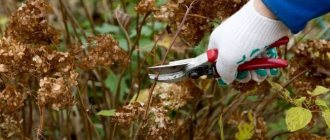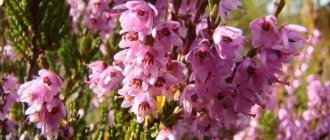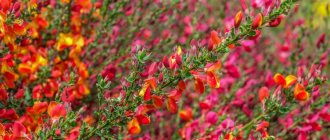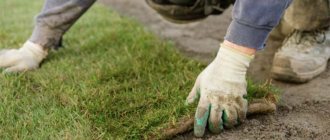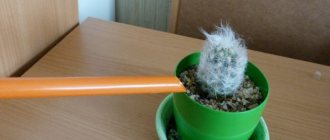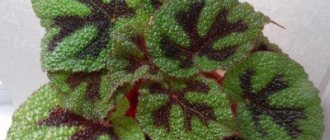How often to water
Proper watering is the main condition for the survival and further development of a healthy rolled lawn cover. The time interval between installation and watering should not exceed one hour in hot weather and no more than two hours on a cool, cloudy day. If the work is a large area, watering can be carried out in parallel with the ongoing installation. A properly watered coating should be abundantly and evenly moistened over the entire area, without bald spots.
Water consumption is approximately 20–30 liters per square meter.
Areas of the lawn that are in sunnier areas require special attention. Insufficiently watered grass can get severe sunburn, which will significantly spoil the aesthetic appearance of the coating, and restoration or replacement will require both time and additional funds.
The watering scheme for the first month after installation looks like this:
- The first seven days. Watering is carried out every day. The basic rule of moistening is a constant time of day for the work being carried out: morning, evening or night. Watering under the scorching sun has a detrimental effect. A well-moistened coating by the end of the first week will delight you with the appearance of a fresh root system. It is also important not to overwater; with moderate watering, the soil under the rolled canvas should be slightly moist.
- After two weeks. Watering is carried out 3-4 times a week. In dry, hot weather, additional moisture without overwatering is acceptable.
- Third week. No more than four times. Add fertilizing with complex mineral fertilizers.
- A month after installation. The lawn is completely ready for use and requires moderate watering as the coating dries .
In dry summer weather, special attention should be paid to moisturizing the coating.
To preserve juicy greens, you should follow some rules:
- moistening should be carried out only after the turf has completely dried;
- water in the morning, evening or night;
- Watering is considered sufficient when the lawn soil is saturated with moisture to a depth of 10 to 15 cm;
- be sure to follow the regime (in the summer, watering is carried out regularly every three to five days);
- avoid overwatering, which provokes the development of fungal diseases;
- The best way to humidify in the summer is to install stationary sprinklers.
In the spring season, watering will not cause much trouble. Moistening occurs naturally; if March-April is still cold, and there is still a snow cap on the surface of the lawn, it is necessary to distribute the snow evenly over the entire coverage area. The formation of puddles in certain areas is unacceptable. Good drainage provided during installation will eliminate excessive waterlogging.
Depending on when the rolled lawn was laid, spring watering may differ:
- if it is only a laid lawn, then you should adhere to the basic scheme designed for a month;
- if the rolled lawn was laid in the fall, you need to focus on weather conditions and then adhere to the general rules. It is especially important to moisten the turf before applying complex fertilizing.
Caring for a rolled lawn: how to replace a new lawn with an old one?
If you are creating a new lawn on an old site, you must remove all of the old turf first! This is very labor intensive, but it is the only way to clear the soil.
If you leave existing grass and weeds, they will quickly grow into new layers and destroy your new lawn. Remove the sod with a shovel, breaking up each piece of sod. Don't dig all the turf at once, do everything gradually. It is better to remove the top layer with the old substrate and replace it with a new and fertile one, on which the new turf will quickly acquire the intense color of lush and green grass.
Lawn care, mole control
A haircut
An aesthetically attractive, even green canvas can never be achieved without proper lawn mowing. Regular mowing prevents excessive evaporation of moisture from the roots of the grass, and also prevents the growth of weeds.
Caring for newly laid roll coverings is especially important:
- The first haircut is done on the 7–8th day after styling. Within a week, the grass should sprout new growth and take root well in its new location.
- The second haircut is carried out on the 14th–20th day. The more often subsequent work is carried out, the denser and smoother the canvas will be.
Before you start cutting, you should familiarize yourself with the basic rules of care:
- Work is carried out only in dry weather; cutting after rain or watering is unacceptable (unsightly furrows will remain on the canvas due to the soggy soil).
- Trimming should not be carried out in sultry hot weather; the plant tissue will receive additional stress after pruning.
- You can cut with hand scissors, a scythe, or a trimmer, but the best result can be achieved by using a cylindrical lawn mower.
- It is important to follow the cutting order: first cut along the strip on two opposite sides, and then make a penetration perpendicular to the strips made.
- Each subsequent haircut should be carried out in a direction perpendicular to the previous one.
- All mowed blades of grass must be removed from the lawn; if the mower does not cope, they are removed using a rake.
- Abundant watering and application of mineral fertilizers after the procedure are required; this will help speed up the recovery process after stress.
We fight weeds on the lawn
Weeds on the lawn are evil, and even the coming autumn does not cause a significant slowdown in their growth. If you haven't fought them yet, you need to do so now because they can spread and next season will be a big problem. Special herbicides are used - that is, dicotyledonous herbicides that fight the most persistent weeds (for example, dandelion, clover, chamomile) and are safe for turf.
If your lawn is next to a vegetable garden, you will need to remove the weeds by hand, digging them up along with the roots to prevent them from growing. Don't throw them in the compost because they can survive even winter. You can burn them, put them in a bucket of water to rot, or "bury" them so they don't disperse. Mow your lawn regularly because mowing your lawn weakens weeds and strengthens the grass.
Lawn care
Feeding and fertilizers
The lawn should be systematically fed, since the cereal grasses that make up the mixture are fast-growing crops. Useful substances for growth and development accumulate in the stems and leaves of plants, but frequent cuttings significantly reduce their supply. The first application of mineral fertilizers is carried out seven days after laying the lawn. The main minerals required for the full development of green leaf are phosphorus, nitrogen and potassium.
Did you know? The first cylindrical lawn mower was invented in 1830 by Edwin Budding, a textile mill worker. The mechanism was a modified unit for trimming the edges of rolls of fabric.
Phosphorus. Promotes the rapid development of the root system, which significantly increases the survival rate of the newly laid canvas. The introduction of phosphorus-containing compounds stimulates active tillering of cereal crops. The substance is also responsible for energy metabolism in plants and the accumulation of nutrients, which help to successfully endure the cold season. Phosphorus is part of complex mineral fertilizers, as well as simple and double superphosphates.
Potassium. Helps develop stable immunity against diseases and overcome adverse weather conditions.
The substance is contained in the following preparations:
- potassium chloride;
- potassium salt;
- potassium sulfate;
- magnesium sulfate.
Nitrogen.
Responsible for the active development of green mass. Promotes active growth, makes the color more saturated.
The highest nitrogen content is in the following fertilizers:
- sodium nitrate;
- calcium nitrate;
- ammonium sulfate;
- ammonium chloride;
- ammonium nitrate;
- urea.
Spring feeding. As soon as a stable positive air temperature has established, and the snow cover has disappeared from the canvas, you can begin fertilizing. In spring it is recommended to apply nitrogen fertilizers. The substance helps the grass recover faster and promotes its active renewal and growth. For a milder effect on plants weakened during the cold period, you should choose liquid preparations in a light chelate form. This will significantly speed up the restoration of green mass.
Fertilizer in the fall. Autumn feeding involves preparing the canvas for wintering. Fertilizers are applied for the last time at the end of October, before the first frost. During this period, complex phosphorus-potassium preparations with a small percentage of nitrogen are added.
This type of care allows you to:
- make plant stems denser and more resistant to adverse weather conditions;
- develop stable immunity to many fungal and other diseases;
- prevent early aging and death of herbs;
- enrich plants with macro- and microelements at the beginning of the active spring period.
Summer feeding. Summer is the season of active growth and development of plants. It is advisable to use rich formulations that contain nitrogen, phosphorus and potassium in a balanced manner. Thanks to such feeding, the plant will harmoniously develop both green ground mass and a strong root system.
Important! The application of mineral fertilizers requires the use of personal protective equipment in the form of a protective mask, gloves and special clothing.
Fertilizer application methods:
- in dry form - granules, which are applied with a special manual spreader. The substance is applied to the coating, passing the area in different directions, which contributes to a more uniform distribution of the fertilizer over the entire area of the lawn. Then carry out abundant watering until the granules are completely dissolved. An undissolved substance can cause burns and significantly spoil the appearance of the canvas;
- Preparations in liquid form are applied using a sprayer, spraying the drug (diluted according to the instructions) onto freshly cut grass. This type of fertilizing occurs through the absorption of the drug by the green mass of the plant and does not require additional watering for at least a day.
Advantages and disadvantages
The advantage of a rolled lawn is the short time it takes to design a site. Seed grass requires 2–3 years to become sufficiently established.
Before you buy lawn grass, you need to weigh the positive and negative qualities of the finished layers.
Before purchasing, examine the bays for uniformity and uniformity of cover.
Pros:
- Provides ready-made lawn coverage immediately after installation, no need to wait 2 years.
- Suppresses the growth of weeds for several years, does not allow them to pass through its own layer.
- The care required is the same as for sowing.
- It is resistant to frost, drought and plant diseases.
- It takes root in a new area without any problems, and if necessary, it can be sown even in late autumn.
Minuses:
- Higher cost compared to the seeding option.
- There is a risk of finding a cheaper lawn, since there are many manufacturers, and purchasing a low-quality coating that will not be accepted well on the site.
- This type of coating grows worse in shaded areas.
- Rolls weigh about 25 kg, independent installation is difficult, if not impossible, and installation with the help of hired workers will add to the list of expenses.
- Shorter service life compared to seed coating.
Scarification
Over time, the vegetation loses its attractiveness. Despite repeated mowing, fertilizing and raking, the remains of dead plants accumulate on the surface, leaving the lawn in a very unsightly appearance. Scarification is a method of removing moss and thatch from the lawn, thereby ensuring the flow of air and light to the lower parts of the plants . Thanks to this care, the applied fertilizers are more effectively distributed over the surface and reach the root system of the cereals faster.
Scarification is recommended to be carried out no more than twice a year:
- in autumn, promoting the formation of dense turf, increasing the thickness of the covering;
- in early spring, preventing the growth of moss and decay after a warm winter.
In order to properly perform scarification, it is necessary to make vertical cuts along the dense layer of turf . The best results can be achieved if the cuts are made alternately: one cut line along, the next one across.
Preparing the lawn for the procedure includes several stages:
- mowing the lawn (grass height should not exceed three centimeters);
- watering the canvas;
- thorough combing with a rake.
In order to carry out scarification, you need to make longitudinal cuts on the grass cloth along the compacted turf layer.
There are several types of devices that cope with the task perfectly:
- powerful gasoline units capable of processing large areas;
- electrical for home use;
- homemade mechanical;
- shoe attachments.
An important criterion that determines the quality of work is the depth of the turf cut, which can be obtained by working with expensive gasoline and electric devices.
How to restore a dried out lawn?
If your lawn was damaged during the summer heat and instead of a carpet of green it looks like a golden tundra, don't wonder what to do with it now. Let's get to work. Before you start watering your lawn, you must first remove all dry grass. If the turf is very compact, it is recommended to buy a special scraper that will help you collect the blades of grass.
The next step is to accurately and abundantly water the grass so that the water reaches the deeper layers of the earth, it must be pierced with a pitchfork. Watering should be repeated for several days in a row. After this regeneration, the turf should turn green within a few weeks. Only then can fertilizers be used (only in the fall, because nitrogen will cause excessive rapid growth!). Nitrogen fertilizers are applied in the spring to give the grass energy to grow.
Lawn care
Weed removal
Weeds not only spoil the attractiveness of the lawn, but can also lead to inevitable degeneration of the surface.
Weeds have a detrimental effect on grasses for several reasons:
- consume nutrients and moisture from the soil;
- lead to the development of fungal diseases;
- provoke the appearance of harmful insects.
If you do not take care and pay due attention, and do not promptly eliminate weeds that weaken the plants, over time, bald spots will appear in the form of weakened plants, the treatment of which will take a lot of time.
There are several reasons for the appearance of weeds on the lawn, including:
- insufficiently thorough preparation of the area before laying the lawn;
- unkempt, neglected condition;
- incorrect selection of lawn grass mixture.
Important! When using herbicides, it is very important to adhere to the recommendations of the drug manufacturers in order to avoid an overdose, which can lead to the death of the grass cover.
Methods for controlling weeds:
- chemical _ In cases of significant weed seeding, the most effective is the use of selective herbicides. The drug is diluted in accordance with the instructions and sprayed in areas of greatest blockage. Work should be carried out in dry weather. Watering is postponed for a day;
- mechanical _ It is not only more efficient, but also quite labor-intensive. This is done manually, using a hoe and a root remover. Cleaning should be done on a moderately damp lawn after watering or rain.
Most weeds can be eradicated by frequent lawn mowing, but there are some that need some work.
The most dangerous weeds that can cause significant damage to a green lawn include:
- Wheatgrass . The most difficult to breed, being close in type to lawn grasses. It is distinguished by a powerful root system that can spread over a meter distance from the mother plant. Wheatgrass is removed mechanically, trying to remove young and old roots from the soil. Even a small missing fragment of the root system can give birth to new powerful plants. In cases of significant coverage of the lawn area, it is possible to use herbicides. They are used with extreme caution, applied directly to the weed with a brush.
- Plantain . The most common weed that spoils the appearance of the coating. Most often it appears in places of high humidity, on compacted soils. For control, they use either a mechanical method, using a root remover, or a chemical method, using local herbicides.
- Dandelion . Most often the plant can be found on young lawns. You can get rid of the weed by frequent mowing and mechanical weeding. As soon as the young cereals close together into a dense turf, the plants that have sprouted from the seeds will not be able to break through the dense layer, and the problem will be solved naturally.
How to restore a lawn?
Right now, October, is when grass seed germinates the fastest, so it's a great time to restore your lawn. You can apply seeds that you have purchased previously, or by purchasing a special renewal/regeneration mixture. It consists of special species and varieties (usually ryegrad), characterized by rapid germination. Since grass seeds are expensive, I use lawn grass seeds "Gavrish" - type of crop: bentgrass. Just right for lawn restoration, cheap and high quality.
Remember that it is not enough to throw seeds into empty and prepared areas, because they can be washed away by rain or birds will peck them. Before sowing, loosen the soil well and mix with new soil (if possible). Only then sow the seeds, and after sowing, cover them with a thin layer of soil and trample them down. Keep in mind that new pieces of sod (from a different seed mix than what you planted your lawn with) may be different in color and vigor than what you already have on your lawn.
Lawn care
Aeration
This event is carried out with the aim of improving the structure of the soil, providing air flow, saturating the soil with oxygen. Packed soil cannot ensure proper penetration of moisture and nutrients to the roots of plants, which leads to the appearance of bald spots, thickets of moss, as well as the growth of green mass stops and the overall growth rate of plants decreases. In this state, the green covering is less resistant to disease and has a hard time withstanding the cold season and stagnant moisture.
Main goals of the event:
- reduce soil density;
- provide air flow to plant roots;
- ensure proper penetration of moisture during the dry season;
- rid the soil of excess moisture and stagnant water, which lead to rotting processes;
- improve the supply of mineral fertilizers to the lower layers of the soil.
Aeration is carried out by piercing the soil. The procedure is carried out once a year. If the lawn is intended for active recreation and has a heavy load and is subject to trampling, then the work is carried out at least two to three times a year.
You should start working if:
- the grass has a faded and limp appearance;
- areas of yellowing are observed;
- the root system of plants is underdeveloped, no more than 5 cm long;
- the turf is very dense and trampled.
Did you know? The Wimbledon tennis court in England is considered one of the most expensive grass surfaces in the world. The court is covered with rolled turf with grass that is grown on the only farm located in Yorkshire, and the technology for growing the surface is kept a special secret.
For aeration in small areas, ordinary forks are used, which pierce the soil to a depth of 10 cm. A good effect can also be achieved using special shoes - aeration sandals , the soles of which are equipped with many hollow knives. For large lawns, verticulators equipped with an electric motor are used. Such units most effectively cope with the task.
Before starting work, a couple of days before the planned aeration, it is necessary to moisten the lawn well. The turf should be moist, but without excess water. Using a verticulator, strips should be drawn across the coating, making an overlap of 4–5 centimeters. If the soil is too dense, you need to go through the unit again. When making punctures a second time, you need to change the angle of movement, heading perpendicular to the strips already made. After a few days, when the turf has dried well, you need to level and break up any compactions with a rake, making the surface of the lawn smooth. In areas of bald spots, it is recommended to reseed the lawn mixture.
Instructions for laying lawn
Site preparation work is carried out immediately before laying the lawn covering. In order for the lawn to be beautiful and last a long time, you need to lay it correctly. The work is carried out in several stages.
- Prepare the area. Level the ground, remove weeds, debris, and stones.
- Create drainage. To do this, the top layer of soil is removed, then the area is covered with pebbles and sand on top. Compaction is carried out and re-filled with earth.
- Start laying from the place where the rolls were unloaded. If you carry them back and forth, the soil may fall off the roots.
- Rolls should only be laid straight. Existing irregularities are first filled or cut off.
- The layers are laid in a checkerboard pattern, strictly observing the shift of the roll by half the length of the previous one. This ensures a tight fit of the layers.
- While working, use wooden shields to avoid walking on the newly laid lawn, as it does not tolerate it well.
- To mark the border of the lawn or to go around a path or flower bed, the boards are trimmed with a knife or shovel.
- The seams are lubricated with a special mixture designed for laying the coating.
- Check each laid roll for depressions, and immediately eliminate them by pouring soil under the layer.
- A special roller is used for compaction.
- Soil should be added between the layers so that the boundaries do not dry out and the roots set faster.
- It takes at least 30 days for the lawn to take root.
Laying rolled turf requires professionalism and skill
Watering the lawn in autumn
As a rule, autumn comes to our latitudes with its constant companion - rainy weather. During September, the soil receives enough moisture, and therefore the lawn should be watered in the fall only during drought (once every 5-7 days). The sprinkling method is an excellent option, but under no circumstances should you allow puddles to form on the lawn, because... this can lead to rotting.
Typically, watering the lawn is stopped in October so that the soil does not become waterlogged and the grass does not weaken and become sick before the onset of cold weather.
Cleaning and combing
After mowing, the lawn is thoroughly cleaned of mown grass and fallen leaves. If this is not done, the grass cover will lose its attractiveness under a layer of uncollected plant debris. It will rain, high humidity will cause diseases of the root system.
It is better to clean every week using a fan rake. Additional benefits of using them are that they loosen the soil and lift the plants. You can work with leaf raking models with plastic and metal flat teeth. They do not injure the stems and root system.
You should comb out thoroughly at different angles, but try not to damage the roots. This procedure will allow new shoots to develop better next year, resulting in a denser lawn. At the same time you need to fight the moss. If it is not possible to remove it mechanically, they resort to herbicides that contain iron sulfates, ammonium sulfates and sand without lime.
